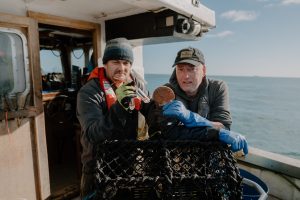Every spring, BOAT International and Blue Marine Foundation host the Ocean Awards, celebrating the people making extraordinary efforts to save our seas. Out of 94 global entries, 23 outstanding projects were shortlisted by our judges, and choosing the winners and runners-up was harder than ever. Here we reveal this year’s well deserved winners…
LOCAL HERO AWARD
Las Chelemeras | Yucatán, Mexico
The Local Hero award recognises an individual, grassroots-based or community-based group whose campaigning, innovation or conservation work is making a positive impact on the marine environment in the place where they live.
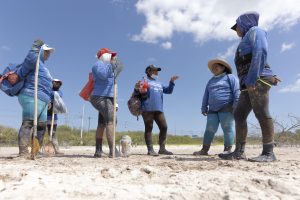
In 2010 the area around the fishing village of Chelem and its lagoon was designated a protected area within the Yucatán Nature Reserve. Since then, a collective of 18 local women, who call themselves Las Chelemeras after their village, have been restoring the mangrove forest. Mangroves protect coastal erosion and prevent sediment from damaging nearby coral reefs and seagrass meadows. They are also powerful carbon sinks, sucking in carbon dioxide from the air.
“At first, we had no idea what we were getting ourselves into,” says Keila Vázquez, whose day job is running a convenience store. Speaking to the film-maker Caitlin Cooper, who nominated them, Vázquez says, “We were housewives who didn’t have much education, and despite the fact that our community depends on fishing, we didn’t understand the importance of these plants and the benefits they brought us.”
How did it first come about?
Two biologists initiated it: Jorge Herrera- Silveira of the Center for Research and Advanced Studies and Claudia Teutli of the National Autonomous University of Mexico’s National School of Higher Education.
What does the work involve?
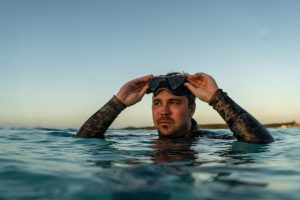
Dr Austin Gallagher and team made the discovery of the world’s largest seagrass meadow, an area of up to 92,000 square kilometres in the Atlantic across the Bahama Banks. Seagrass captures carbon up to 35 times faster than tropical rainforests, and this area is believed to be the ocean’s largest carbon sink.
They also took the step of “partnering with wild tiger sharks” to map the area. Gallagher’s paper, Tiger sharks support the characterisation of the world’s largest seagrass ecosystem, was published by Nature Communications in November 2022.
How do you “partner” with sharks?
Gallagher has had a passion for sharks ever since he researched his PhD on shark physiology and behaviour. He has been the lead scientist on more than 50 expeditions, published 100-plus scientific papers – on, among other subjects, the migration of ocean giants, blue carbon and deep-sea exploration – and is also a host, expert and producer of the Discovery Channel’s enduringly popular annual Shark Week each summer. In 2019 he began to explore how sharks might themselves contribute to conservation efforts, and on this project, it was, he says, “Sharks [that] led us to the seagrass ecosystem in the Bahamas.”
Sharks led him to the site, but he wrangled them too?
In a manner of speaking. The sharks were caught using circle hook drumlines that hook into their jaws and cause no long-term damage. Then cameras and trackers were fixed onto their dorsal fins with biodegradable cable ties. A time-released swivel was designed to dissolve in seawater after 24 hours so the gear could float to the surface where it could be picked up and analysed.
Six sharks effectively mapped the area, revealing meadows twice the size of those in the lagoon between Australia’s mainland and the Great Barrier Reef, which was previously understood to be the largest on Earth. A seventh shark carried a 360-degree camera, and radio and satellite tags were fixed on eight further sharks to record data on water temperature and depth.
And sharks proved better than humans at collecting this sort of data?
They did. Not only do they cover more ground at greater speed, but they were also able to reach “areas that were not logistically possible for human access”. Gallagher and his team found them seven times more effective at capturing high-resolution images. And the data they were able to draw from these (and findings from 2,542 diver surveys) “proved important in supporting mapping and ground-truthing remote sensing estimates”.
But really, this is about seagrass, not sharks?
It is, because apart from providing habitats and food for a range of marine life, not least manatees and green turtles, seagrass is critical to mitigating climate change. This paper increases estimates of how much seagrass covers the entire ocean bed by an encouraging 41 per cent. As Gallagher and his team write, “The conservation of seagrass ecosystems is of critical global importance to managing greenhouse gas emissions while safeguarding the many threatened species and seafood resources supported by seagrass habitat. “This discovery should also give us hope for the future of our oceans because it demonstrates how everything is connected. And that the untapped potential of the ocean is limitless.”
PUBLIC AWARENESS AWARD: LOCAL WINNER
Zandile Ndhlovu | The Black Mermaid Foundation
This award highlights an individual or group whose work has advanced public knowledge and understanding of an issue affecting the health of the oceans through campaigning, advocacy, education, social or mainstream media or the arts, with local impact.
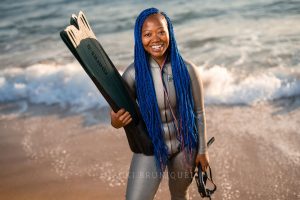
Judges were impressed by The Black Mermaid, produced by Zandile Ndhlovu, the first black African freediving instructor in South Africa. The film explores the relationship that black communities have with water and follows her expedition to see the sardine run, a marine phenomenon off the coast of KwaZulu-Natal when billions of pilchards spawn, creating a feeding frenzy that draws up to 18,000 dolphins, as well as sharks and Bryde’s, humpback, southern right and minke whales. The Black Mermaid is available to view on WaterBear, the interactive streaming platform dedicated to conservation.
How did this project come about?
Growing up inland in Soweto, Ndhlovu did not see the sea until she was 12. “Never in my wildest dreams did I think a world like this existed just beneath the surface,” she recalls. Then, in 2016, she went snorkelling in Bali. “I’d never seen anything so beautiful. All these weird and wonderful animals were coexisting at the bottom of the ocean, while on land, the world is so banded in identity, race and gender. I decided I wanted to make it more accessible to black communities.”
How did she get started?
“From the first moment I went freediving, I knew I wanted to tell everyone who would listen about it, “ she says. “I’ve always dreamt of making a positive impact in the lives of others, and, more importantly, I wanted to teach. And when I qualified [as a freediving instructor] in 2020, I knew this was my ticket to creating the change I wanted to see in the world.
“Learning to swim is often the first step into connecting with the marine world, but only 15 per cent of South African people can swim, and a large proportion of this statistic is made of white people. My dream is to expand this narrative [by teaching people to swim, snorkel and freedive, because] the ocean belongs to us all.”
Tell us about Black Mermaid Foundation
“It is an organisation that seeks to create diverse representation in the ocean, recreationally, professionally and in sport, while creating a new generation of ocean guardians. I might have to take 500 kids snorkelling to get one passionate. But that’s still worth it. I have a passion that I’m determined to share with the world.”
PUBLIC AWARENESS AWARD: GLOBAL WINNER
Frozen Ocean | BBC Natural History Unit
This award highlights an individual or group whose work has advanced public knowledge and understanding of an issue affecting the health of the oceans through campaigning, advocacy, education, social or mainstream media or the arts, with a global impact.
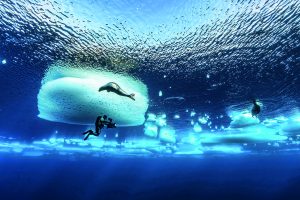
First broadcast in the UK on BBC1 in September 2022 and still available to watch on BBC iPlayer, Frozen Ocean is the second episode of the six-part documentary series Frozen Planet II, an affecting, astonishingly beautiful film, rigorously researched and shot through with strong scientific messaging.
Where was it filmed?
It focused exclusively on the Arctic – above and below the ice in Canada, Greenland, Norway, Russia and the US – and was shot over three years.
How many people watched it?
Its first airing in the UK attracted an audience of 5.71 million, making it the third-most-watched programme that week. Made by BBC Studios Natural History Unit and co-produced with BBC America, the Open University, Migu Video, ZDF (Germany), France Télévisions and NHK (Japan), Frozen Planet II has subsequently been screened all over the world. It’s fair to say no one who’s seen it will forget it. Not least those polar bears dancing on ice; that heartbreaking baby harp seal parted from its mother after just 12 days; those tiny transparent skeleton shrimps scaling the giant kelp forest; and the pod of 30 starving beluga whales trapped by an exceptionally cold winter in “tiny pocket of water” off the coast of Arctic Russia because the next breathing hole was 30 kilometres away.
An exceptionally cold winter? Surely it’s rising temperatures that are threatening the Arctic?
Yes and no. The Arctic is warming faster than anywhere else on Earth. Last June, temperatures of more than 32°C were reported in the Arctic Circle, and it is predicted that the Arctic Ocean could be free of ice by 2035. It’s climate change overall that is the issue. Think of those seal pups washed to their deaths during terrible storms.
Will Frozen Ocean make a difference?
It is certainly raising awareness. As its narrator, Sir David Attenborough, says on camera in a call to action at the end of the final episode, “If we can do something about it, then do it. We can do it. We must do it. Then there will be a future for the planet.”
LIFETIME ACHIEVEMENT
Lisa Speer | Ocean Advocate and Conservationist
This award acknowledges an outstanding career that has made a demonstrable difference to knowledge of the world’s oceans and what needs to be done to improve and conserve their health.

This year’s recipient is Lisa Speer, director of the International Oceans Program at the Natural Resources Defense Council and member of the High Seas Alliance’s steering committee. Natural Resources Defense Council is a US non-profit with global reach that “works to safeguard the earth”, while the High Seas Alliance is a partnership of more than 40 organisations dedicated to conserving the oceans.
Why was she nominated?
“Lisa has been a prominent leader in securing transformative conservation victories at the United Nations level,” says her nominator, Brittany Baschuk, environmental policy consultant in Washington, DC. “These victories include the standalone UN Sustainable Development Goal 14, to conserve and sustainably use the oceans, seas and marine resources, and the Global Biodiversity Framework’s 30×30 target. She also spearheaded conservation elements in the negotiations for the new UN High Seas Treaty (see postscript). Besides [that, she] also advocates for integrated, ecosystem-based management in the Arctic.”
And what else?
“She has also accompanied a number of official US delegations to international high-seas fisheries’ negotiations,” says Baschuk, “and has testified before Congress and the UN on a variety of high-seas and Arctic-management issues.”
She was also instrumental in: persuading US Congress to put its West and East Coasts, as well as the Eastern Gulf of Mexico, off limits to drilling in the Outer Continental Shelf; the passing of the Oil Pollution Act following the catastrophic Exxon Valdez spill in Prince William Sound, Alaska; the classification of beluga sturgeon as an endangered species, which led to a ban on the import of beluga caviar to the US; implementing the first United Nations agreement on bottom trawling in the High Seas.
What is she focusing on now?
Speer has been helping pull together a coalition to push for the implementation of a new agreement for the UN Convention on the Law of the Sea to regulate biological diversity on the high seas.
Postscript
The day after the Ocean Awards judges met to decide this year’s winners, UN member states finally agreed on a treaty to protect the High Seas, a decision that has taken them two decades to reach. Speer was part of the UN negotiating team. As she told National Public Radio’s Morning Edition the next day, the biggest conservation-related accomplishment of the new treaty is that it lays the groundwork for the establishment of large-scale marine protected areas, which she described as the “ocean’s equivalent of a Grand Canyon or Yellowstone National Park”. The treaty also covers an exhaustive range of issues from the commercialisation of “marine genetic resources”, which have the potential to be used in pharmaceuticals and cosmetics, to “who gets to decide what happens in this global commons” to the establishment of global standards for environmental impact assessments on commercial activities in the ocean. “It’s important because billions of people around the world rely on the ocean for basic needs. For their food, their jobs, their income, their sustenance, culturally as well as economically. “And the science tells us that this is the single most important thing we can do to enhance ocean resilience in the face of growing threats from climate change.”
YOUNG INITIATIVE AWARD
Brigitta Gunawan | Founder of 30×30 Indonesia, Bali
This award is open to individuals aged between 18 and 30 whose vision and commitment, professional or voluntary, to improving the ocean environment indicates they will become a future leader in the field of marine conservation or science. Winner this year is Brigitta Gunawan.

What is 30×30 Indonesia?
It aims to “inspire people of all generations to take action to protect 30 per cent of the world’s ocean by 2030 in order for us to have a future”, she says. She aims to do this by “leveraging diverse community efforts through education, policy, advocacy and habitat restoration”.
What inspired her to set it up?
“It was born out of the recognition that there is so much to learn about the ocean and so much to be done and that so much more can be achieved collectively,” she says. “Whether it’s ocean policy, marine ecosystems or habitat restoration, people of all ages from anywhere in the world can learn something new [and be inspired] to protect the ocean and become ocean advocates in their own communities.”
2022 was quite a year…
“Last year was filled with incredibly special moments,” she agrees, “ranging from international conferences in four countries”, including Asia Parks Congress in Kota Kinabalu on Sabah in Malaysia, and two trips she made to Washington DC as a member of the Youth Leadership Council of EarthEcho International “to direct habitat restoration of mangroves and coral reefs”.Gunawan marked Earth Day in April by mobilising volunteers to create the 30×30 Coral Garden off Tulamben on the northeast coast of Bali. And for World Ocean Day, she organised a team of students who planted 200 mangroves in Jakarta. In November, 30×30 Indonesia hosted its Youth Ocean Conference in Jakarta and Bali. And in December, she spoke at the UNLEASH Global Innovation Lab in India.
And last year’s highlight?
“Addressing world leaders at the Plenary Hall of the United Nations Ocean Conference in Lisbon [where I was] called on stage by [Marcelo Rebelo de Sousa] President of Portugal,” and followed by Emmanuel Macron, president of France.
What is next?
Having won a scholarship to Monash University in Melbourne last year, she is now an undergraduate in its marine biology department. But she’s not about to quit campaigning. “My journey has only just begun, and being a student is a stepping stone [towards] reaching greater heights. If anything, it’s an opportunity to directly apply my learnings to the real world.”
Are there grounds for optimism?
“Yes, most definitely. Our recent accomplishments with the 30×30 target at COP15 in Montreal and the High Seas Treaty should act as a reminder that we have come a long way to get to where we are now.”
The Judges: HRH Princess Eugenie | Professor Martin Attrill University of Plymouth | Sofia Blount trustee of Blue Marine Foundation | Stephen Catlin executive chairman, Convex | George Duffield co-founder, Blue Marine Foundation | Hugh Fearnley-Whittingstall writer, broadcaster and campaigner | Frederikke Magnussen, co-founder, A Plastic Planet | Professor Callum Roberts University of Exeter | Professor Alex Rogers science director, REV Ocean | Professor Yvonne Sadovy University of Hong Kong. Co-chairs: Sacha Bonsor, editor-at-large, BOAT International | Charles Clover executive director, Blue Marine Foundation

